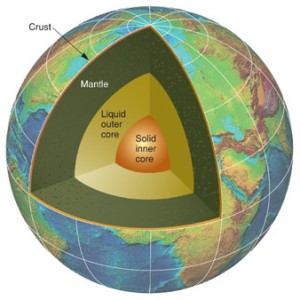15 December 2010
Seismic waves open a window into the inner core
Posted by mohi
Seismic waves move through the Earth’s deep core at different speeds, depending on where they are and in which direction they’re going.
Six hundred kilometers beneath the Americas, vibrations generated by earthquakes travel faster when they’re traveling north or south, compared to east or west. It’s as though the seismic waves are following highways running from pole to pole, but meandering along windy country lanes when they’re moving along the equator. But in the inner core below Asia, the roadways are the same in any direction–wave speeds are consistent regardless of where they’re headed.
Previously, scientists knew that the crust and mantle beneath the Eastern and Western hemispheres were different through studies of seismic waves that travel through Earth.
But Arwen Deuss, of UK’s University of Cambridge showed in a talk in DI21C “Structure and Dynamics of Earth’s Core I” that this difference between hemispheres also exists in the Earth’s inner core and not just in the shallower mantle. Through studying 90 major earthquakes, she and her colleagues investigated the way the whole planet “rings like a bell” at low frequencies (less than 10 megahertz) when the Earth trembles. The pattern of inner core behavior during these earthquakes show clear differences between eastern and western hemispheric sections.
But more than that, transitional regions beneath the hemispheres under the Pacific ocean and Africa are so wide that it makes more sense to divide the inner core into quarters: one with a strong north-south preference for wave speeds (the Americas), one with almost no difference between north-south and east-west (Asia), and one east and one west of the Americas that gradually transition to Asia’s lack of seismic heterogeneity.
Before I heard Deuss’ presentation, I thought little of the Earth’s inner core, being more concerned with the daily grind on the Earth’s surface. But now I that I know that seismic waves gives scientists a window into the deepest reaches of the Earth–far beyond the crust and mantle–I wonder what else might be going on miles beneath my feet!
–Sascha Zubryd is a science communication graduate student at UC Santa Cruz











 GeoSpace is a blog on Earth and space science, managed by AGU’s Public Information staff. The blog features posts by AGU writers and guest contributors on all sorts of relevant science topics, but with a focus on new research and geo and space sciences-related stories that are currently in the news.
GeoSpace is a blog on Earth and space science, managed by AGU’s Public Information staff. The blog features posts by AGU writers and guest contributors on all sorts of relevant science topics, but with a focus on new research and geo and space sciences-related stories that are currently in the news.